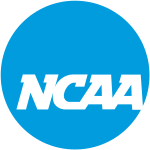
National Collegiate Athletic Association
American collegiate athletic organization / From Wikipedia, the free encyclopedia
Dear Wikiwand AI, let's keep it short by simply answering these key questions:
Can you list the top facts and stats about National Collegiate Athletic Association?
Summarize this article for a 10 years old
The National Collegiate Athletic Association (NCAA)[lower-alpha 2] is a nonprofit organization that regulates student athletics among about 1,100 schools in the United States, and Canada.[3] It also organizes the athletic programs of colleges and helps over 500,000 college student athletes who compete annually in college sports.[3] The organization is headquartered in Indianapolis, Indiana.
 | |
| Abbreviation | NCAA |
|---|---|
| Founded | March 31, 1906; 117 years ago (1906-03-31) in New York City, U.S.[lower-alpha 1] |
| Legal status | Association |
| Headquarters | Indianapolis, Indiana, U.S. |
Region served | United States and Canada[2] |
Membership | about 1,100 schools[3] |
President | Charlie Baker |
Main organ | Board of Governors |
| Website | ncaa.com, ncaa.org |
| NCAA divisions |
|---|
Until 1957, the NCAA was a single division for all schools. That year, the NCAA split into the University Division and the College Division.[4] In August 1973, the current three-division system of Division I, Division II, and Division III was adopted by the NCAA membership in a special convention. Under NCAA rules, Division I and Division II schools can offer scholarships to athletes for playing a sport. Division III schools may not offer any athletic scholarships. Generally, larger schools compete in Division I and smaller schools in II and III. Division I football was further divided into I-A and I-AA in 1978, while Division I programs that did not have football teams were known as I-AAA. In 2006, Divisions I-A and I-AA were respectively renamed the Football Bowl Subdivision (FBS) and Football Championship Subdivision (FCS). In its 2016–17 fiscal year, the NCAA took in $1.06 billion in revenue, over 82% of which was generated by the Division I men's basketball tournament.
Controversially, the NCAA formerly capped the benefits that collegiate athletes could receive from their schools. The consensus among economists is these caps for men's basketball and football players benefit the athletes' schools (through rent-seeking) at the expense of the athletes.[5][6][7] Economists have subsequently characterized the NCAA as a cartel.[8][9][10] On June 21, 2021, the Supreme Court of the United States unanimously ruled that the education-related benefit caps the NCAA imposes on student athletes are in violation of US antitrust law.[11]